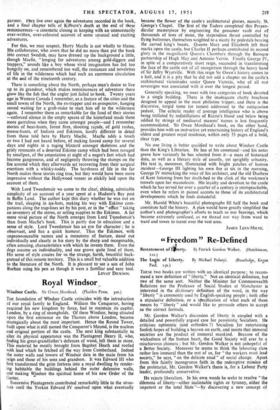Royal Windsor
Windsor Castle. Sir Owenjvlorshead. (Phaidon Press. 3os.) THE foundation of Windsor Castle coincides with the introduction of our royal family to England. William the Conqueror, having acquired his new kingdom by force, had to maintain its capital, London, by a ring of strongholds. Of these Windsor, being situated upon the first eminence on the Thames above London, became strategically about the most important. Hence the Round Tower, built upon what is still named the Conqueror's Mound, is the nucleus and, original portion of the castle. The next king substantially to alter its physical appearance was the Plantagenet Henry II, who, finding his great-grandfather's defences of wood, left them in stone. This material he mostly brought from Bagshot 'Heath and roofed with lead which he fetched all the way from Cumberland. Indeed the outer walls and towers of Windsor date in the main from his reign and those of his sons and grandson. It was Edward III who first transformed the grim fortress into a royal dwelling by render- ing habitable the buildings behind the outer defensive walls, and making Wjndsor the •spiritual home of his new Order' of the Garter.
Successive Plantagenets contributed remarkably little to the struc- ture until the Yorkist Edward -1V resolved upon what eventually became the flower of the castle's architectural glories, namely, St. George's Chapel. The first of the Tudors completed this Perpen- dicular masterpiece by engineering the gossamer vault out of thousands of tons of stone, the stupendous thrust controlled by flying buttresses, themselves weighted to a nicety by pedestals bearing the carved king's beasts. Queens Mary and Elizabeth left their marks upon the castle, but Charles II perhaps contributed its second glory in the magnificent Queen's Chambers through the Baroque partnership of Hugh May and Antonio Verrio. Finally George IV, in spite of a comparatively short reign, succeeded in transforming the face of the castle out of all recognition through the heavy hand of Sir Jeffry Wyatville. With this reign Sir Owen's history comes to a halt, and it is a pity that he did not add a chapter on the castle's architectural vicissitudes under Queen Victoria, who of all our sovereigns was associated with it over the longest period.
Generally speaking, we meet with two categories of book devoted to a single building. There is the inadequate chatty brochure designed to appeal to the most philistine tripper, and there is the discursive, turgid tome (or tomes) addressed to the antiquarian pedant. The eclectic reader of average intelligence who is above being titillated by redistillations of Rizzio's blood and below being edified by strings of mediaeval masons' names is less frequently accommodated. Sir Owen Morshead's book, on the other hand, provides him with an instructive yet entertaining history of England's oldest and greatest royal residence, within only 53 pages of a bold, clear type.
No one living is better qualiOed to write about Windsor Castle than the King's Librarian. He has at his command—and his notes prove how variously he has selected from it—a mass of historical data, as well as a literary style of courtly, yet sprightly urbanity. His text is, moreover, illuminated with bright patches of human incident—George III lighting his own fire at six in the morning, George IV mimicking the voice of his architect, and the old Duchess of Kent listening from her death-bed to the clink of the workmen's trowels upon her mausoleum. His loyalty and devotion to the castle which he has served for over a quarter of a century is unimpeachable, even when he refers in pained accents to those of its architectural developments which he finds distasteful.
Mr. Harold White's beautiful photographs fill half the book and constitute half the history. A plan would have greatly simplified the author's and photographer's efforts to teach us our bearings, which' become extremely confused, as we thread our way from ward to ward and tower to turret over the vast area.
JAMES LEES-MILNE.






























 Previous page
Previous page